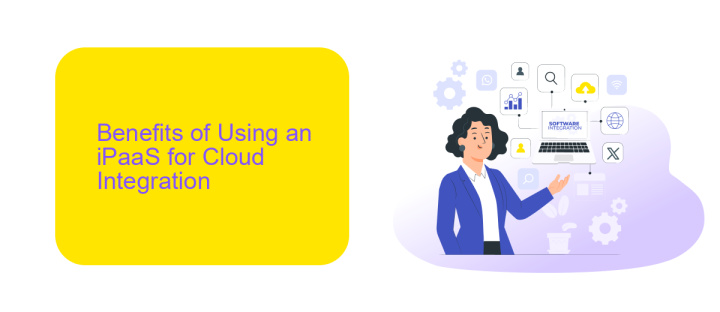iPaaS Cloud Integration
In today's fast-paced digital landscape, businesses are increasingly turning to Integration Platform as a Service (iPaaS) solutions to streamline their operations and enhance connectivity. iPaaS offers a seamless way to integrate various cloud-based and on-premises applications, enabling efficient data flow and improved collaboration. This article explores the benefits, key features, and best practices for leveraging iPaaS for optimal cloud integration.
Introduction to iPaaS Cloud Integration
Integration Platform as a Service (iPaaS) represents a cloud-based solution designed to facilitate seamless integration between disparate systems and applications. This technology enables organizations to connect various software and data sources, ensuring efficient data flow and process automation. By leveraging iPaaS, businesses can enhance productivity, streamline operations, and reduce manual intervention.
- Automated data synchronization between multiple systems
- Real-time data integration and monitoring
- Scalability to meet growing business needs
- Enhanced security and compliance
- Cost-effective and easy to deploy
One of the notable iPaaS providers is ApiX-Drive, which simplifies the integration process by offering a user-friendly platform. With ApiX-Drive, users can effortlessly connect various applications and automate workflows without any coding knowledge. This service supports numerous integrations, ensuring that businesses can maintain a cohesive and efficient IT ecosystem. Ultimately, iPaaS solutions like ApiX-Drive empower organizations to focus on their core activities while the platform handles the complexities of integration.
Benefits of Using an iPaaS for Cloud Integration

Utilizing an iPaaS (Integration Platform as a Service) for cloud integration provides significant benefits, including enhanced efficiency and streamlined workflows. By automating data synchronization between disparate cloud applications, businesses can eliminate manual data entry, reducing errors and saving valuable time. This seamless integration ensures that all systems are up-to-date with real-time data, leading to better decision-making and improved operational agility.
Moreover, iPaaS solutions like ApiX-Drive offer user-friendly interfaces that simplify the setup of complex integrations without requiring extensive coding knowledge. This democratizes the integration process, allowing non-technical users to configure and manage integrations effortlessly. Additionally, iPaaS platforms often include robust monitoring and analytics tools, which provide insights into integration performance and help identify potential issues before they impact business operations. Overall, adopting an iPaaS for cloud integration fosters a more connected and efficient business environment.
Key Features to Look for in an iPaaS Solution

When choosing an iPaaS solution, it's essential to consider key features that will ensure seamless integration and efficient workflow management. A robust iPaaS platform should offer comprehensive tools to facilitate data synchronization, process automation, and real-time monitoring.
- Ease of Use: The platform should have an intuitive interface that allows users to set up integrations without extensive technical knowledge.
- Scalability: Ensure the solution can handle increasing data volumes and complex workflows as your business grows.
- Pre-built Connectors: Look for a wide range of pre-built connectors to popular applications and services, like ApiX-Drive, which simplifies the integration process.
- Security: Robust security measures, including data encryption and compliance with industry standards, are crucial for protecting sensitive information.
- Real-time Monitoring and Analytics: The ability to monitor integrations in real-time and access detailed analytics helps in maintaining optimal performance and quickly addressing any issues.
By focusing on these key features, you can select an iPaaS solution that not only meets your current integration needs but also supports future growth and technological advancements. ApiX-Drive, for instance, offers a user-friendly interface and a variety of pre-built connectors, making it a strong candidate for businesses looking to streamline their integration processes.
Best Practices for Implementing an iPaaS-Based Integration Strategy

Implementing an iPaaS-based integration strategy requires careful planning and execution to ensure seamless connectivity between various applications and data sources. Begin by thoroughly understanding your business requirements and identifying the key applications and data flows that need integration.
Next, select an iPaaS provider that aligns with your business needs. ApiX-Drive, for example, offers a user-friendly interface and robust capabilities for connecting a wide range of applications. Its pre-built connectors can significantly reduce the time and effort required for integration.
- Define clear integration goals and objectives.
- Ensure data security and compliance with regulations.
- Leverage pre-built connectors to speed up the integration process.
- Regularly monitor and optimize integration performance.
- Provide adequate training for your team on using the iPaaS platform.
Finally, maintain flexibility in your integration strategy to adapt to changing business needs. Regularly review and update your integrations to ensure they continue to meet your objectives. By following these best practices, you can maximize the benefits of your iPaaS-based integration strategy and drive greater efficiency in your operations.
Case Studies and Success Stories
One notable case study involves a mid-sized e-commerce company that significantly improved its operational efficiency through iPaaS cloud integration. By leveraging ApiX-Drive, the company was able to seamlessly connect its CRM, email marketing, and inventory management systems. This integration not only automated data transfer between platforms but also provided real-time analytics, enabling the company to make informed decisions swiftly. As a result, the company saw a 30% increase in sales and a 20% reduction in operational costs within six months.
Another success story features a healthcare provider that utilized iPaaS to integrate patient management systems with billing and telehealth services. Using ApiX-Drive, the provider created a unified platform that streamlined patient data management and improved billing accuracy. This integration reduced administrative workload by 40% and enhanced patient satisfaction due to faster and more reliable service delivery. The healthcare provider also reported a 25% increase in revenue, attributing this growth to the efficiencies gained through iPaaS integration.


FAQ
What is iPaaS?
How does iPaaS benefit businesses?
Can iPaaS be used for both on-premises and cloud applications?
Is coding required to use iPaaS?
What should I consider when choosing an iPaaS provider?
Strive to take your business to the next level, achieve your goals faster and more efficiently? Apix-Drive is your reliable assistant for these tasks. An online service and application connector will help you automate key business processes and get rid of the routine. You and your employees will free up time for important core tasks. Try Apix-Drive features for free to see the effectiveness of the online connector for yourself.

